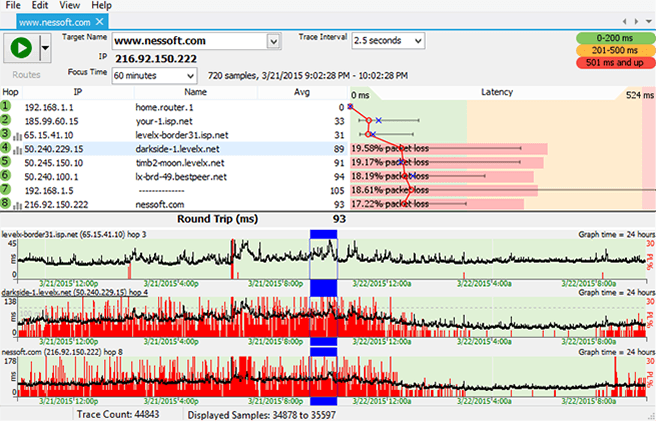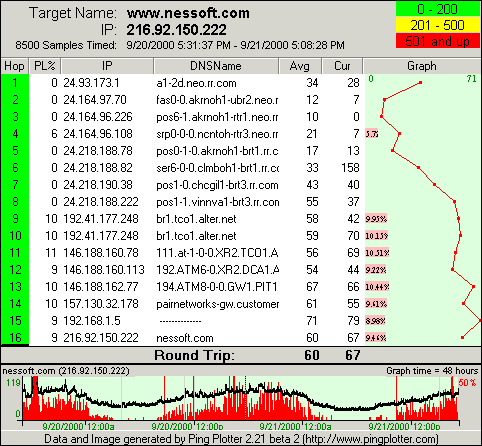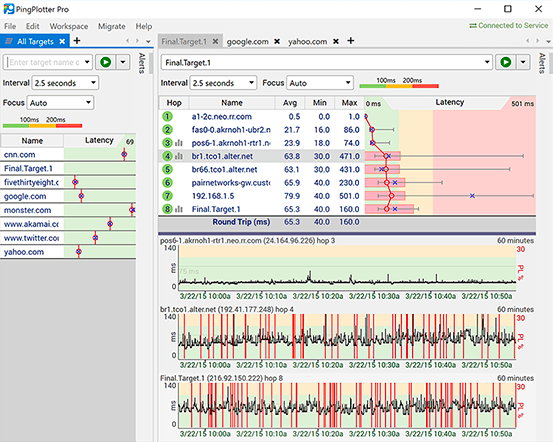
Be aware that a too-small number can adversely affect your data. If you have just oodles of bandwidth, you can crank it down a little. If you've adjusted your packet size, or your connection to the internet is really slow, you might want to crank this number up a little. This falls within realm of what a 28.8 modem can perform. This time interval is adjusted by this parameter. Actually, it leaves a tiny interval between each packet so as not to completely saturate your bandwidth when it sends out 30 packets.


PingPlotter sends out multiple packets at the same time and times everything at once. It's really meant for "advanced" users, so you don't NEED to change it. This can be an interesting number to manipulate. If it's set too low, it can cause misleading data to be generated. No matter what your value is here, timed out packet will show with the time "9999."īecause of the performance enhancements offered by PingPlotter, it's unlikely that this option needs to be changed. If patience isn't one of your virtues, you can turn this down somewhat. If the packet doesn't return in 3 seconds, then it is counted as a lost packet. The longer it waits, the more resources it needs to use (to keep sockets open), but the more likely that it will get a response By default, PingPlotter will wait for 3 seconds for any packet to return. When PingPlotter sends out a packet, it waits a certain amount of time for a response. This option allows you to fine-tune your performance a little. This requires Administrative user rights and, on most operating systems, also requires the installation of a helper library such as Npcap. TCP is the protocol used for all web browsers in addition to FTP, Telnet, and others. If a firewall is blocking ICMP packets, it’s sometimes possible to get a response using TCP packets instead. This method gives you the opportunity to send TCP packets.
PINGPLOTTER MANUAL WINDOWS
This requires administrative rights, and doesn't work reliably on Windows Vista or newer (including Windows 8). Though not the cure-all for "Destination Unreachable" issues, this is worth a try, especially if you’re getting erratic packet loss or unreachable destination. This method will sometimes allow you to trace to a destination that isn’t reachable via ICMP, or might allow you to reach the internet even if your ISP is blocking ICMP echo requests. This uses ports 33434 – 33500 and closely mirrors Unix’s traceroute command.


This requires administrative rights and doesn't work reliably on Windows Vista or newer (including Windows 8). PingPlotter can compose its own ICMP packets - although in most cases this is no more reliable or better than ICMP.DLL. In some rare cases, the standard Windows method doesn't work.
PINGPLOTTER MANUAL MANUAL
This method will automatically do manual timings on less-than-accurate operating systems to attempt to get accuracy to 1ms. This is reliable with the least CPU usage (on most operating systems). It works on all Windows operating systems, and is a good balance of reliability and capability. This method is the traditional method and matches the data that the Windows TRACERT command uses. The "Packet Type" settings allows you to pick what kind of data you want to send to tailor PingPlotter to your network needs. The "Engine" settings control what and how PingPlotter sends data.


 0 kommentar(er)
0 kommentar(er)
